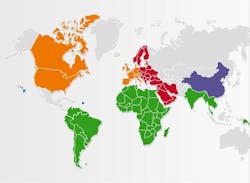General Electric yesterday signaled that it is about to become more visible and aggressive in the increasingly competitive microgrid market.
“The technology is ready, and we are now ready to scale up,” said Herve Amosse, GE’s general manager for grid automation, siting an increasingly viable business case for microgrids as renewable energy costs fall.
The Connecticut-based company is among a growing field of international technology giants pursuing the microgrid market. Others include ABB, Hitachi, Schneider Electric and Siemens. In the U.S., the market is pegged at just over $550 million and is expected to exceed $1.3 billion in four years, according to GTM Research.
So far less visible in the microgrid market than many of its competitors, GE has been quietly honing technology, working on prototypes, striking deals and designing and developing microgrids in a handful of states, as well as internationally in Canada, France and Singapore.
Microgrids changing the world
In a presentation for the press called, “How Microgrids are Changing the World,” Amosse and three other GE smart grid executives outlined the company’s work to date and its strategy ahead.
GE is drawing upon its own technology and products to build microgrids, including primary equipment at the low and medium voltage level, generation and storage assets, and software and analytics.
Where it cannot use its own products, GE is partnering with utilities and private companies, a common practice because of the diversity of equipment and expertise that goes into building microgrids.
GE’s role in the microgrid market will be that of technology provider, designer and developer; it does not plan to own and operate microgrids, according to Amosse.
As is the case for many microgrid developers, New York is an epicenter of activity for GE because of the NY Prize, a $40 million state sponsored competition to incentivize microgrids. GE is working with 10 communities, seven partners and five utilities to develop conceptual designs for Stage 1 NY Prize projects. The projects are both urban, suburban and rural. Several are on Long Island.
Each of GE’s New York projects is unique and includes a range of generation types, including micro-hydro, solar plus storage and natural gas, according to Lavelle Freeman, manager of distribution planning & engineering for GE Consulting.
Potential Microgrid Applications Around The World
Freeman described each New York project “as a microcosm of the modern distribution system” that fulfils the objective of New York’s Reforming the Energy Vision (REV), “where one of the key drivers is that prosumers – consumers who also produce energy – should have more control over the future.”
In Maine, GE brought automated islanding to a 10 MW microgrid project at the Portsmouth Naval Shipyard, a U.S. nuclear facility.
Several times a year outages would shut down the base, and startup and islanding would take three to four hours to complete manuually, according to Eliot Assimakopoulos, business leader for government solutions at GE’s Grid Solutions.
So GE installed a microgrid control platform to automate the facility’s islanding capability. It also worked with energy service company Ameresco to add energy storage to the facility, which is used to accrue revenue through participation in ISO New England’s frequency regulation market.
The Portsmouth microgrid was commissioned late last year with a load shedding demonstration.
In France, GE has developed a solar and storage microgrid in Nice, now in operation for two years and collecting data, according to Laurent Schmitt, smart grid strategy leader for GE’s Grid Solutions. The microgrid optimizes solar panels installed by about 1,500 residential, commercial and industrials, which are used to strenghten the grid.
The microgrid market ahead
Amosse said that it is clear to GE that microgrid technology is ready. However, government regulation lags.
“The regulatory framework is not in entirely in place for enabling revenue, he said, citing potential microgrid revenue streams in the retail and wholesale markets or via building microgrids to defer transmission upgrades.
“We think it is going to be in place moving forward. It is then going to clarify the business case and facilitate investment,” he said.
Track the microgrid market by subscribing to the free Microgrid Knowledge newsletter.









